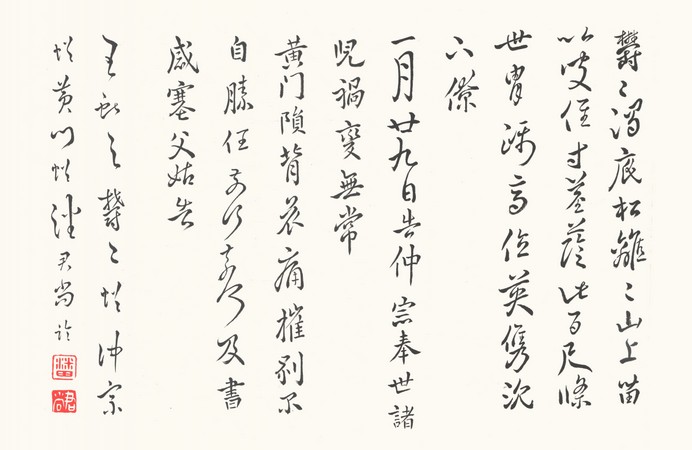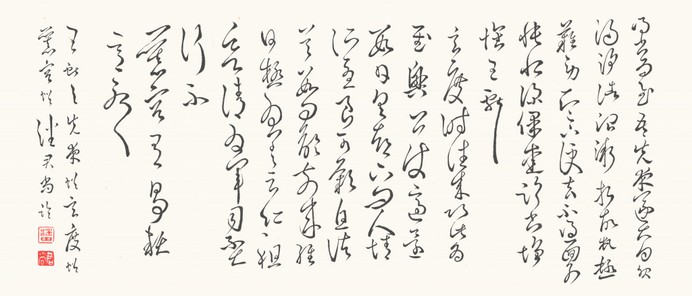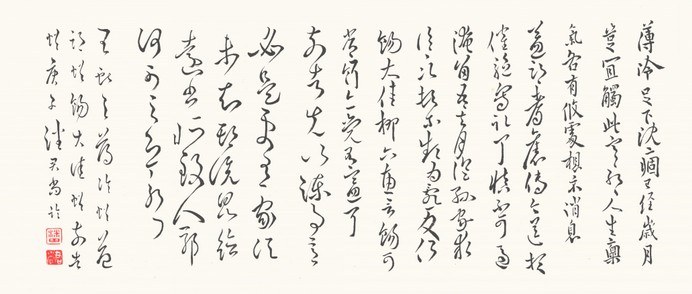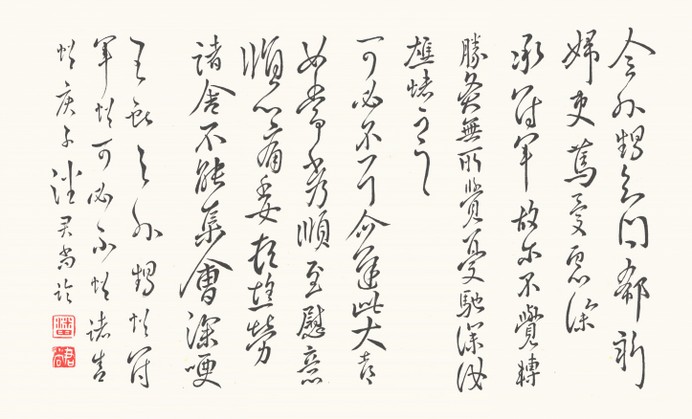Galleries and Translations > Models of Masterpieces > Models of Masterpieces by Wang Xianzhi (part III) 臨王獻之諸法帖 (第三部份)
Models of miscellaneous Exemplary Masterpieces by Wang Xianzhi (part III) 臨王獻之諸法帖 (第三部份)
Historical information
(I)
Wang Xianzhi (王獻之, 344-386AD) was the seventh son of “The Sage of Calligraphy (書聖)” Wang Xizhi (王羲之, 303–361AD). At an early age of seven, his extraordinary talents in calligraphy had already been recognized by his father (七八歲時學書,羲之密從後掣其筆不得,歎曰:「此兒後當復有大名。」)(1). Although he later developed a rather unrestraint and unconventional personality (高邁不羈…風流為一時之冠) (2), his cursive and standard scripts were widely admired (工草隸)(3) for their liberating and serene demeanours (逸氣縱橫)(4). Thus, along with his father, he was regarded as one of the Four Talents (四賢) in the art of Chinese calligraphy(5).
(II)
Despite Wang Xianzhi’s brilliance, his calligraphy was not without criticism. The Book of Jin narrated that his calligraphy lacked strength and sturdiness compared to that of his father (獻之骨力遠不及父)(6). Sun Guoting, in his Narrative on Calligraphy, went even further to chastized his arrogance and thus concluded that his art was undoubtedly inferior to his father’s (子敬之不及逸少,無或疑焉)(7). Such criticisms serve as good reminders that the ultimate foundation of Chinese calligraphy is the refinement of temperaments, not techniques(8).
(III)
The calligraphies presented below are my models of Wang Xianzhi's handwriting found in Chunhua Imperial Archive of Calligraphy Exemplars (《淳化閣帖》). Supposedly, these handwritings were short letters and memos scribed by Wang. Although their authenticities are questionable, they are still often regarded as Exemplary Masterpieces (法帖) for calligraphers to study and observe. In the art of Chinese calligraphy, "帖(pronounced as Tie)" refers to an exemplary work that should be studied by all .
(IV)
Since the originals in the Chunhua Imperial Archive of Calligraphy Exemplars (《淳化閣帖》) can be parts of or whole letters/memos scribed by Wang, translations that are provided below, if available, may not be entirely precise, for they can be interpreted out of context. Further, whether Wang had actually scribed them remains questionable. Accordingly, scholars should be wary of using these as authentic historical references.
____________________________________________
(1) 房玄齡,《晉書》卷八十王羲之列傳. 北京:中華書局, 1974, p.2105.
(2) Ibid., p.2104.
(3) Ibid., p.2104.
(4) 張懷瓘《書斷》. 《歷代書法論文選》. 上海: 上海書畫出版社, 1979, p.164.
(5) KS Vincent Poon & Kwok Kin Poon, A Narrative on Calligraphy by Sun Guoting Revised and Enhanced Edition 英譯書譜 增訂版. Toronto: The SenSeis, 2019, pp.9-10.
(6) 房玄齡,《晉書》卷八十王羲之列傳. 北京:中華書局, 1974, p.2106.
(7) KS Vincent Poon & Kwok Kin Poon, A Narrative on Calligraphy by Sun Guoting Revised and Enhanced Edition 英譯書譜 增訂版. Toronto: The SenSeis, 2019, p.15.
A model of Yu Yu Tie (鬱鬱帖) or Jian Di Song Tie (澗底松帖), Zhong Zong Tie (仲宗帖), and Huang Men Tie (黃門帖)
35 X 53 cm
Click to Enlarge. Reserved, not available in shop.
Yu Yu Tie (鬱鬱帖) or Jian Di Song Tie (澗底松帖):
Original Classical Chinese: 鬱鬱澗底松,離離山上苗。以彼徑寸莖,蔭此百尺條。世冑躡高位,英儁沈下僚。
English: This was a part of the second poem of Yong Shi (《詠史》) by Zuo Si (左思, approx. 250-305AD ). This particular part can be loosely translated as follows:
鬱鬱澗底松,
The luscious and sturdy (鬱鬱) pine trees stood by the river below,
離離山上苗。
the drooping and spineless (離離)* sprouts settle on the mountain above.
以彼徑寸莖, 蔭此百尺條。
By appling their (以彼) inch-wide stems (徑寸莖), the sprouts overshadow (蔭) the hundred-foot tall trees.
世冑躡高位,英儁沈下僚。
(Just like) The patrimonial nobles (世冑) rise to high power, while the brilliant minds sink to lowly offices.
(Interpreted by KS Vincent Poon, Feb. 2021)
*(離離) should be better interpreted as “drooping (下垂的樣子)” to contrast the sturdy pine trees in the first sentence, as suggested in 重編國語辭典修訂本 :
離離, 下垂的樣子。漢張衡《西京賦》:「神木靈草,朱實離離。」
Zhong Zong Tie (仲宗帖):
Original Classical Chinese: 一月廿九日。告仲宗奉世。諸兒禍變無常。
English: NA. The entire phrase may not be translated, for the context in which it was written is unknown or uncertain.
Huang Men Tie (黃門帖):
Original Classical Chinese: 黃門隕背。哀痛摧剝,不自勝任。奈何、奈何。及書感塞。父姑告。
English: NA. The entire phrase may not be translated, for the context in which it was written is unknown or uncertain.
A model of Xian Ye Tie (先夜帖), Xuan Du Tie (玄度帖), and Mu Rong Tie (慕容帖)
35 X 82 cm
Click to Enlarge. Reserved, not available in shop.
Xian Ye Tie (先夜帖):
Original Classical Chinese: 得書為慰。吾先夜遂大得服湯酒,諸治漸折。故頓極難勞。知足下便去。不得面別,悵恨深。保愛。臨書增懷。王獻之白。
English: NA. The entire phrase may not be translated, for the context in which it was written is unknown or uncertain.
Xuan Du Tie (玄度帖):
Original Classical Chinese: 玄度時往來。以此為慰。興公使適還數日。具都下問。人情所憂,良可歎息。諸吳數問。齡前來經日。極為差。云仁祖欲請為軍司。不知行不。
English: NA. The entire phrase may not be translated, for the context in which it was written is unknown or uncertain.
Mu Rong Tie (慕容帖):
Original Classical Chinese: 慕容有易賴意耶。
A model of Bao Leng Tie (薄冷帖), Yi Bu Tie (益部帖), Tang Da Jia Tie (餳大佳帖), and Qian Gao Tie (前告帖)
35 X 82 cm
Click to Enlarge. Reserved, not available in shop.
Bao Leng Tie (薄冷帖):
Original Classical Chinese: 薄冷,足下沈痼已經歲月,豈宜觸此寒耶。人生禀氣,各有攸處,想示消息。
English: NA. The entire phrase may not be translated, for the context in which it was written is unknown or uncertain.
Yi Bu Tie (益部帖):
Original Classical Chinese: 益部耆舊傳,今送。想催絕寫取耳。慎不可過淹留。吾去月從孫家求信。信次頓爾。頻為亂反側。
English: NA. The entire phrase may not be translated, for the context in which it was written is unknown or uncertain.
Tang Da Jia Tie (餳大佳帖):
Original Classical Chinese: 餳大佳。柳下惠言,餳可常餌。亦覺有益耳。
English: NA. The entire phrase may not be translated, for the context in which it was written is unknown or uncertain.
Qian Gao Tie (前告帖):
Original Classical Chinese: 前告先以陳事。意必是。更有家信,未知期說。見德遠書所致人耶。何可足念耶。
English: NA. The entire phrase may not be translated, for the context in which it was written is unknown or uncertain.
A model of Wai Sheng Tie (外甥帖), Cheng Guan Jun Tie (承冠軍帖), Ke Bi BuTie (可必不帖), and Zhu She Tie (諸舍帖)
35 X 57 cm
Click to Enlarge. Reserved, not available in shop.
Wai Sheng Tie (外甥帖):
Original Classical Chinese: 令外甥知問。郗新婦更篤。憂慮深。
English: NA. The entire phrase may not be translated, for the context in which it was written is unknown or uncertain.
Cheng Guan Jun Tie (承冠軍帖):
Original Classical Chinese: 承冠軍故爾,不覺轉勝。灸無所覺,憂馳深,汝燋悚可言。
English: NA. The entire phrase may not be translated, for the context in which it was written is unknown or uncertain.
Ke Bi BuTie (可必不帖):
Original Classical Chinese: 可必不耳,企遲。此大都如常。秀、順至,慰意。順心痛委頓憔勞。
English: NA. The entire phrase may not be translated, for the context in which it was written is unknown or uncertain.
Zhu She Tie (諸舍帖):
Original Classical Chinese: 諸舍不能集會。深哽
English: NA. The entire phrase may not be translated, for the context in which it was written is unknown or uncertain.



